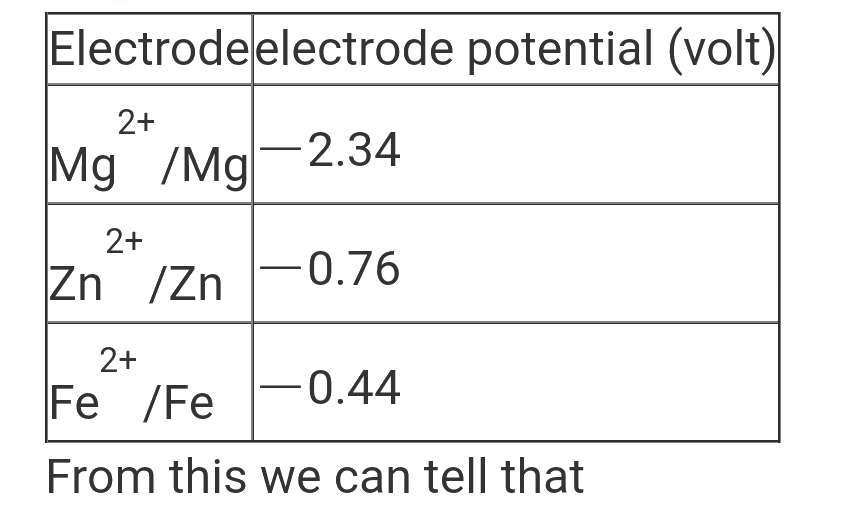Consult the table of standard electrode potentials and suggest three substances that can oxidise ferrous ions under suitable conditions.
The correct Answer is:HNO3,F2, acidified dichromate
Species having higher reduction potential than Fe3+/Fe2+, can oxidise Fe2+ ions to Fe3+.
Topper's Solved these Questions
- ELECTROCHEMISTRYBOOK - ICSECHAPTER - ELECTROCHEMISTRYEXERCISE - EXERCISE (PART-I Objective Questions)
28 Videos
- ELECTROCHEMISTRYBOOK - ICSECHAPTER - ELECTROCHEMISTRYEXERCISE - EXERCISE (PART-I Objective Questions) (Choose the correct alternative)
25 Videos
- ELECTROCHEMISTRYBOOK - ICSECHAPTER - ELECTROCHEMISTRYEXERCISE - ISC EXAMINATION QUESTIONS (PART-II Numerical Problems)
19 Videos
- DISTINCTION BETWEEN PAIRS OF COMPOUNDS BOOK - ICSECHAPTER - DISTINCTION BETWEEN PAIRS OF COMPOUNDS EXERCISE - QUESTIONS
155 Videos
- GENERAL PRINCIPLES AND PROCESSES OF ISOLATION OF ELEMENTS BOOK - ICSECHAPTER - GENERAL PRINCIPLES AND PROCESSES OF ISOLATION OF ELEMENTS EXERCISE - EXERCISE (PART-I ( OBJECTIVE QUESTIONS )) (Fill in the blanks)
60 Videos
Similar Questions
Consult the table of standard electrode potential and suggest three substances that can oxidize Fe2+ ions under suitable conditions.
View SolutionOn the basis of standard electrode potential values,suggest which of the following reactions would take place? (Consult the book for Eϴ value)
(a) Cu+Zn2+→Cu2++Zn
(b) Mg+Fe2+→Mg2++Fe
(c ) Br2+2Cl−→Cl2+2Br−
(d) Fe+Cd2→Cd+Fe2+
View Solution
Knowledge Check
Assertion:Lithium has the lowest electrode potential.
Reason: Lithium ion is the strongest oxidising agent.AIf both assertion and reason are true and reason is the correct explanation of assertion .BIf both assertion and reason are true but reason is not the correct explanation of assertion .CIf assertion is true but reason is false .DIf both assertion and reason are false .
(i) On the basis of the standard electrode potential values stated for acid solutions, predict whether Ti4+ species may be used to oxidise Fe(II) to Fe(III)
Ti4++e−→Ti3+E∘=+0.01VFe3++e−→Fe2+E∘=+0.77V
(ii) Based on the data arrange Fe3+,Mn2+ and Cr2+ in the increasing order of stability of +2 oxidation state. (Give a brief reason)
E∘Cr3+/Cr2+=−0.4V
E∘Mn3+/Mn2+=+1.5V
E∘Fe3+/Fe2+=+0.8V
View SolutionValue of standard electrode potential for the oxidation of Cl− ions is more positive than that of water, even then in the electrolysis of aqueous sodium chloride, why is Cl− oxidsied at anode instead of water?
View SolutionThe potential associated with each electrode is known as electrode potential. If the concentration of each species taking part in the electrode reaction is unity (if any appears in the electrode reaction, it is confined to 1 atmospheric pressure) and further the reaction is carried out at 298 K, then the potential of each electrode is said to the standard electrode potential. By convention, the standard electrode potential of hydrogen electrode is 0.0 volt. The electrode potential value for each electrode process is a measure of relative tendency of the active species in the process to remain in the oxidised/reduced form. A negative E∘ means that the redox couple is a stronger reducing agent than the H+/H2 couple. A positive E∘ means that the redox couple is a weaker reducing agent than the H+/H2 couple. The metal with greater positive value of standard reduction potential forms the oxide of greater thermal stability.
Which of the following reactions is not correct ?
View SolutionThe potential associated with each electrode is known as electrode potential. If the concentration of each species taking part in the electrode reaction is unity (if any appears in the electrode reaction, it is confined to 1 atmospheric pressure) and further the reaction is carried out at 298 K, then the potential of each electrode is said to the standard electrode potential. By convention, the standard electrode potential of hydrogen electrode is 0.0 volt. The electrode potential value for each electrode process is a measure of relative tendency of the active species in the process to remain in the oxidised/reduced form. A negative E∘ means that the redox couple is a stronger reducing agent than the H+/H2 couple. A positive E∘ means that the redox couple is a weaker reducing agent than the H+/H2 couple. The metal with greater positive value of standard reduction potential forms the oxide of greater thermal stability.
Which of the following couples will have highest value of emf ?
View SolutionThe standard reduction potential at 298 K for single electrodes are given below.l

From this we can tell that
View SolutionUsing the standard electrode potentials given in the Table 8.2, predict if the reaction between the following is feasible:
Ag(s) and Fe3+(aq)
View SolutionUsing the standard electrode potentials given in the Table 8.2, predict if the reaction between the following is feasible:
Ag+(aq) and Cu(s)
View Solution
